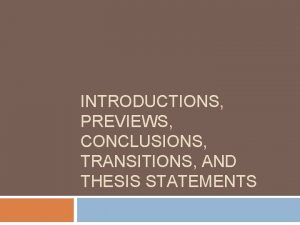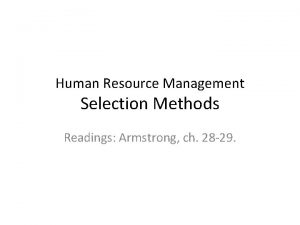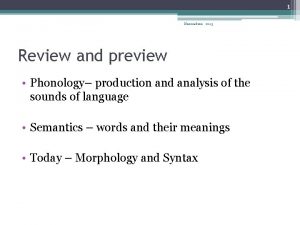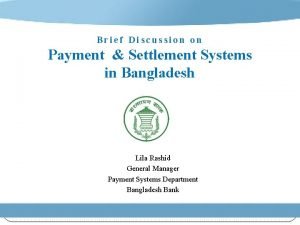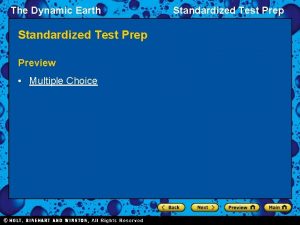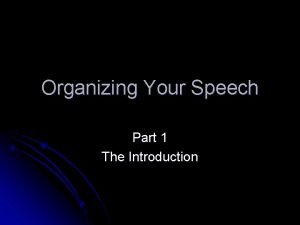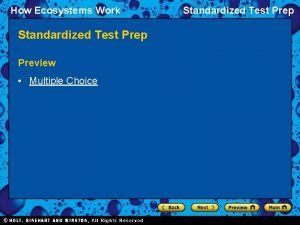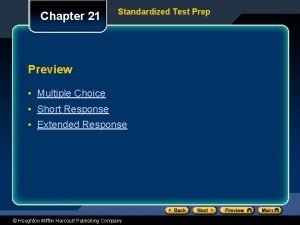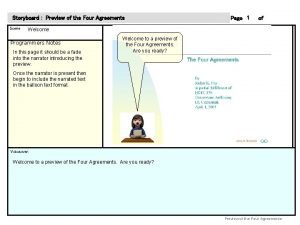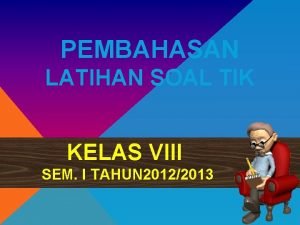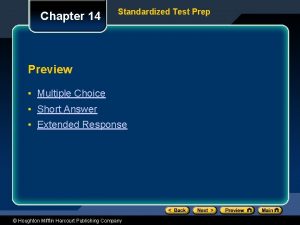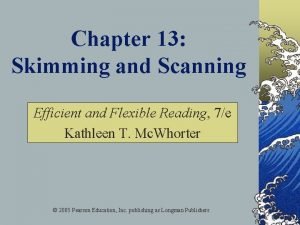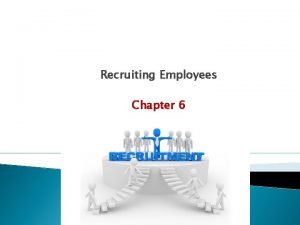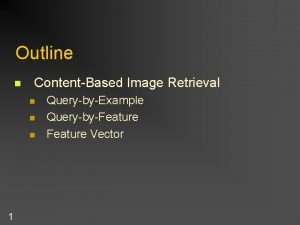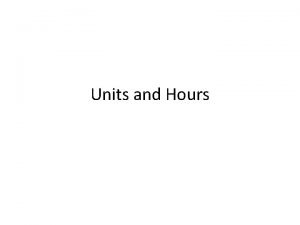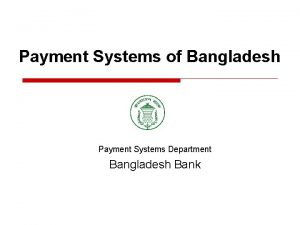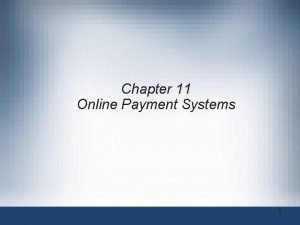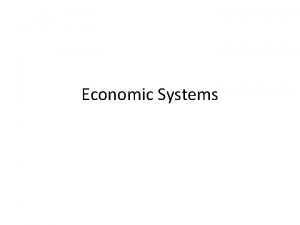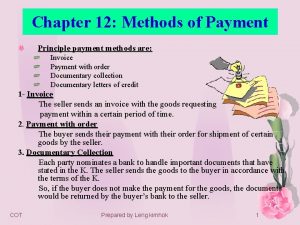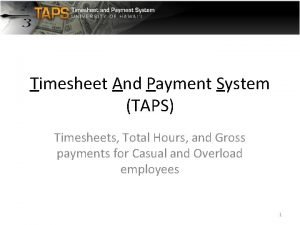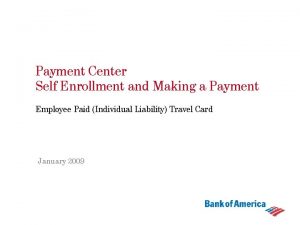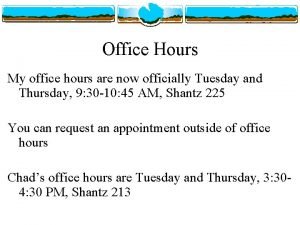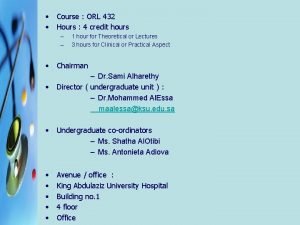Chapter 8 PAYMENT SYSTEMS AND WORKING HOURS PREVIEW





































- Slides: 37


Chapter 8 PAYMENT SYSTEMS AND WORKING HOURS

PREVIEW q q q The different types of payment structures, including basic pay, benefits and incentives. Wage systems currently in use. Factors which influence the quantum of wages paid by employers to employees. The legal requirements which impact the payment of wages. The provisions of the Employment Act 1955 on working hours. HRM Principles and Practices Third Edition © Oxford Fajar Sdn. Bhd. (008974 -T), 2014 All Rights Reserved 1– 3

PREVIEW (cont. ) q Overtime working. q The shift system of working. q Alternative work schedules such as flexitime, job -sharing and part-time work. q The advantages of teleworking and working from home. HRM Principles and Practices Third Edition © Oxford Fajar Sdn. Bhd. (008974 -T), 2014 All Rights Reserved 1– 4

PREVIEW The reasons why employers offer benefits to employees. q The statutorily required benefits. q Some common non-statutory benefits. q The various methods of rewarding employees. q HRM Principles and Practices Third Edition © Oxford Fajar Sdn. Bhd. (008974 -T), 2014 All Rights Reserved 1– 5

THE IMPORTANCE OF WAGE SYSTEMS q Wages are important to employees—standard of living and status q Wages are important to employers—cost of production q Wages are important to society— competitiveness of Malaysian businesses HRM Principles and Practices Third Edition © Oxford Fajar Sdn. Bhd. (008974 -T), 2014 All Rights Reserved 1– 6

REMUNERATION PACKAGE REMUNERATION WAGES BENEFITS HRM Principles and Practices Third Edition © Oxford Fajar Sdn. Bhd. (008974 -T), 2014 INCENTIVES All Rights Reserved 1– 7

GOALS OF REMUNERATION SYSTEMS Employer’s Goals q To maximize profits q To have an attractive package q To retain the best employees q To have a system simple to administer q To maximize income q To have a stable income HRM Principles and Practices Third Edition © Oxford Fajar Sdn. Bhd. (008974 -T), 2014 All Rights Reserved 1– 8

WAGE SYSTEMS q Time-related system q Piece-work/payment by results q Combination HRM Principles and Practices Third Edition © Oxford Fajar Sdn. Bhd. (008974 -T), 2014 All Rights Reserved 1– 9

FACTORS AFFECTING LEVELS OF PAY INTERNAL FACTORS Compensation policy of organization Worth of the job Employee’s relative worth EXTERNAL FACTORS Wage Mix The labour market Cost of living Collective bargaining Legal requirements Employer’s ability to pay HRM Principles and Practices Third Edition © Oxford Fajar Sdn. Bhd. (008974 -T), 2014 All Rights Reserved 1– 10

FACTORS OF INDIVIDUAL EMPLOYEE’S WAGES Seniority q Degree of skill and experience q Increase in the cost of living q Performance q Equal pay for equal work? HRM Principles and Practices Third Edition © Oxford Fajar Sdn. Bhd. (008974 -T), 2014 All Rights Reserved 1– 11

LEGISLATION RELEVANT TO REMUNERATION q The Employment Act q The Sabah Labour Ordinance q The Sarawak Labour Ordinance q The National Wages Consultative Council Act HRM Principles and Practices Third Edition © Oxford Fajar Sdn. Bhd. (008974 -T), 2014 All Rights Reserved 1– 12

LEGISLATION RELEVANT TO REMUNERATION (cont. ) q q q q Frequency of wage payment Timing of wage payment Mode of payment Advances on wages Deductions from wages Situations when wages are not required to be paid Failure to pay wages HRM Principles and Practices Third Edition © Oxford Fajar Sdn. Bhd. (008974 -T), 2014 All Rights Reserved 1– 13

LEGISLATION RELEVANT TO REMUNERATION (cont. ) MINIMUM WAGES As of 1 January 2016: q Minimum Wage in Peninsular Malaysia = RM 1000 per month/ RM 4. 81 per hour q Minimum Wage in Sabah & Sarawak = RM 920 per month/ RM 4. 42 per hour HRM Principles and Practices Third Edition © Oxford Fajar Sdn. Bhd. (008974 -T), 2014 All Rights Reserved 1– 14

LEGISLATION RELEVANT TO REMUNERATION (cont. ) MINIMUM WAGES (cont. ) q Is the minimum wage of RM 900/RM 800 adequate? q How often should the minimum wage be revised? q Should the minimum wage be the same throughout the country? q What is the likely impact of the minimum wage on employers, employees and the country? HRM Principles and Practices Third Edition © Oxford Fajar Sdn. Bhd. (008974 -T), 2014 All Rights Reserved 1– 15

WORKING HOURS Restrictions on working hours established by the Employment Act and SLOs: No employee shall be required under his contract to work: more than 8 hours per day or q more than 48 hours per week or q more than 5 consecutive hours without a 30 -minute break q HRM Principles and Practices Third Edition © Oxford Fajar Sdn. Bhd. (008974 -T), 2014 All Rights Reserved 1– 16

WORKING HOURS (cont. ) Employees within the scope of the Employment Act and SLOs are entitled to: q q q One rest day per week Minimum public holidays: Employment Act = 10 Sabah Lab. Ord. = 14 S’wak Lab. Ord. = 16 HRM Principles and Practices Third Edition © Oxford Fajar Sdn. Bhd. (008974 -T), 2014 All Rights Reserved 1– 17

WORKING HOURS (cont. ) Overtime Work q Overtime work, i. e. work done outside the normal hours of work is permitted up to a maximum of 104 hours per month. q Overtime work cannot be made compulsory except in certain circumstances and in certain industries (the essential services). HRM Principles and Practices Third Edition © Oxford Fajar Sdn. Bhd. (008974 -T), 2014 All Rights Reserved 1– 18

WORKING HOURS (cont. ) Overtime work must be paid at premium rates. q Monthly rated workers are entitled to 1. 5 x their hourly rate of pay when they work overtime hours. q An employee may not be permitted to work more than 12 hours per day inclusive of overtime. q HRM Principles and Practices Third Edition © Oxford Fajar Sdn. Bhd. (008974 -T), 2014 All Rights Reserved 1– 19

OVERTIME WORK ADVANTAGES: § Production or service levels increase without hiring extra workers § Provides opportunity for workers to increase their income DISADVANTAGES: § Higher cost per hour of labour § May cause fatigue which leads to accidents § May cause dissatisfaction amongst workers HRM Principles and Practices Third Edition © Oxford Fajar Sdn. Bhd. (008974 -T), 2014 All Rights Reserved 1– 20

SHIFT WORK Types of Shift Work q q q Double day Triple shift Continuous Semi-continuous Split shift Rotating or fixed shift HRM Principles and Practices Third Edition © Oxford Fajar Sdn. Bhd. (008974 -T), 2014 All Rights Reserved 1– 21

SHIFT WORK (cont. ) q Does shift work cause health problems? q Are shift workers as productive as non-shift workers? q What are the costs of shift work? HRM Principles and Practices Third Edition © Oxford Fajar Sdn. Bhd. (008974 -T), 2014 All Rights Reserved 1– 22

ALTERNATIVE WORK SCHEDULING Flexitime Job-sharing Part-time working Teleworking Homeworking HRM Principles and Practices Third Edition © Oxford Fajar Sdn. Bhd. (008974 -T), 2014 All Rights Reserved 1– 23

WHY PROVIDE BENEFITS? Many benefits are compulsory under the following laws: q Employment Act q Sabah Labour Ordinance q Sarawak Labour Ordinance q Employees Provident Fund Act q Employees Social Security Act q Workmen’s Compensation Act HRM Principles and Practices Third Edition © Oxford Fajar Sdn. Bhd. (008974 -T), 2014 All Rights Reserved 1– 24

WHY PROVIDE BENEFITS? (cont. ) Benefits can: q Help attract staff to join the organization q Help retain existing employees q Increase morale of employees, which may lead to higher productivity HRM Principles and Practices Third Edition © Oxford Fajar Sdn. Bhd. (008974 -T), 2014 All Rights Reserved 1– 25

STATUTORY BENEFITS q Maternity leave q Sick leave q Annual leave q Paid public holidays q Contribution to Employees Provident Fund q Contribution to Employees Social Security Organization or Purchase of insurance policy HRM Principles and Practices Third Edition © Oxford Fajar Sdn. Bhd. (008974 -T), 2014 All Rights Reserved 1– 26

NON-STATUTORY BENEFITS Time-off payments: q Marriage q Birth of a child (paternity leave) Personal emergencies Pilgrimage Studies Death of a relative q q HRM Principles and Practices Third Edition © Oxford Fajar Sdn. Bhd. (008974 -T), 2014 All Rights Reserved 1– 27

NON-STATUTORY BENEFITS (cont. ) Health care: q Payment of medical bills q Hospitalization benefits q Payment of optical bills q Payment of dental bills HRM Principles and Practices Third Edition © Oxford Fajar Sdn. Bhd. (008974 -T), 2014 All Rights Reserved 1– 28

NON-STATUTORY BENEFITS (cont. ) Other benefits: q Insurance (other than SOCSO) q Financial services q Discounted goods/services q Retirement benefits q Educational assistance HRM Principles and Practices Third Edition © Oxford Fajar Sdn. Bhd. (008974 -T), 2014 All Rights Reserved 1– 29

FLEXI-BENEFITS/CAFETERIA BENEFITS Employees may be offered a menu of benefits from which to choose. Limits will be set for different groups of employees. q The package of benefits is thus customized by each employee for his personal needs and can be changed as his needs change. q HRM Principles and Practices Third Edition © Oxford Fajar Sdn. Bhd. (008974 -T), 2014 All Rights Reserved 1– 30

REWARDS Incentives and rewards: q Drive behaviour to higher levels q Create competition q Help to retain the best performers HRM Principles and Practices Third Edition © Oxford Fajar Sdn. Bhd. (008974 -T), 2014 All Rights Reserved 1– 31

REWARDS (cont. ) To be effective, reward schemes must: q Allow many employees to be winners q Be perceived as fair q Drive suitable behaviours q Be perceived as attractive HRM Principles and Practices Third Edition © Oxford Fajar Sdn. Bhd. (008974 -T), 2014 All Rights Reserved 1– 32

FINANCIAL REWARDS q Wage increments q Bonuses q Profit-sharing schemes q Commissions HRM Principles and Practices Third Edition © Oxford Fajar Sdn. Bhd. (008974 -T), 2014 All Rights Reserved 1– 33

NON-FINANCIAL REWARDS q Performance awards q Letters of appreciation q Long service awards q Sponsorship to attend conferences q Award ceremonies q Tokens of appreciation HRM Principles and Practices Third Edition © Oxford Fajar Sdn. Bhd. (008974 -T), 2014 All Rights Reserved 1– 34

REVIEW q The reasons why employers offer benefits to employees. q The statutorily required benefits. q Some common non-statutory benefits. q The various methods of rewarding employees. HRM Principles and Practices Third Edition © Oxford Fajar Sdn. Bhd. (008974 -T), 2014 All Rights Reserved 1– 35

REVIEW q The different types of payment structures, including basic pay, benefits and incentives. q Wage systems currently in use. q Factors which influence the quantum of wages paid by employers to employees. q The legal requirements which impact the payment of wages. q The provisions of the Employment Act 1955 on working hours. HRM Principles and Practices Third Edition © Oxford Fajar Sdn. Bhd. (008974 -T), 2014 All Rights Reserved 1– 36

REVIEW (cont. ) q Overtime working. q The shift system of working. q Alternative work schedules such as flexitime, job-sharing and part-time work. q The advantages of teleworking and working from home. HRM Principles and Practices Third Edition © Oxford Fajar Sdn. Bhd. (008974 -T), 2014 All Rights Reserved 1– 37
 Payment systems and working hours
Payment systems and working hours Eti base code
Eti base code Hot working and cold working difference
Hot working and cold working difference Hot hot
Hot hot Differentiate between hot working and cold working
Differentiate between hot working and cold working Examples of cold working and hot working
Examples of cold working and hot working Thesis example
Thesis example Thesis and preview statement example
Thesis and preview statement example What is a preview statement
What is a preview statement Classic trio' of selection techniques
Classic trio' of selection techniques Review and preview
Review and preview Benefits of hr forecasting
Benefits of hr forecasting Hard work vs smart work presentation
Hard work vs smart work presentation Npsb vs beftn
Npsb vs beftn Test prep preview
Test prep preview Test prep preview
Test prep preview Test prep preview
Test prep preview Test prep preview
Test prep preview Sccm technical preview
Sccm technical preview Startling statement introduction examples
Startling statement introduction examples Test prep preview
Test prep preview Nnn preview
Nnn preview The selection preview
The selection preview Chapter 21 standardized test practice answers
Chapter 21 standardized test practice answers The four agreements preview
The four agreements preview Test prep preview
Test prep preview Perintah print preview kita jalankan dari menu
Perintah print preview kita jalankan dari menu Test prep preview
Test prep preview Preview skimming
Preview skimming 1984 book preview
1984 book preview Yandex.ru video
Yandex.ru video Nút lệnh print preview nằm ở đâu
Nút lệnh print preview nằm ở đâu Tams college acceptance
Tams college acceptance Disadvantages of realistic job preview
Disadvantages of realistic job preview Multi-channeled definition in communication
Multi-channeled definition in communication Preview speech
Preview speech Paraverbal communication definition
Paraverbal communication definition Nnn image preview
Nnn image preview








